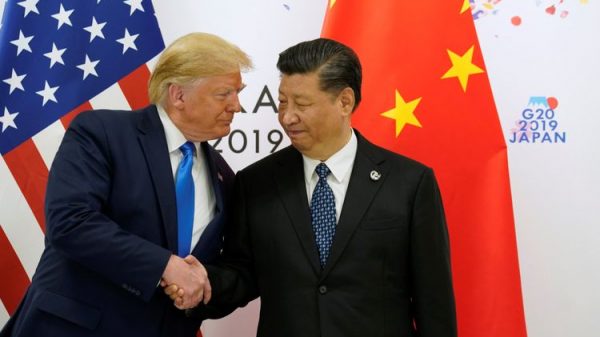How US-China could create ‘multi-bilateral’ world order

Andrew Hammond and Risto Penttila : It is now more than a decade since then-French President Nicolas Sarkozy declared that “the G20 foreshadows the planetary governance of the twenty-first century”. Yet, last week’s summit in Japan underlined that there is a significant danger that the forum – prized by member-states for the status it brings – may potentially wither away as a key multilateral organ in the face of resurgent bilateralism, especially in US-China relations.The US-China relationship, sometimes known as the G2, was centre stage again in Japan, as at the Argentinian G20 last year. In an eagerly awaited Donald Trump-Xi Jinping meeting, the two leaders last week agreed to a truce in their potential trade war, although Beijing indicated on Friday that it will not reach a deal with Washington unless all US sanctions are rolled back.
The G20, which accounts for some 90 per cent of global GDP, 80 per cent of world trade, and around 66 per cent of global population, has been a key political story since the turn of the millennium. Upgraded from a finance minister body to one where heads of state have met since 2008, it was supposed to be a step toward a more inclusive global leadership in the liberal world order. The intent was nothing short of seizing the mantle from the G7 as the premier forum for economic cooperation and economic governance. But that has not happened in the decisive way expected, as indicated by the growing prominence of US-China relations.To be sure, the G20 played a significant role in stopping the international economy nosedive during the 2008-09 financial crisis into what could have been a new Great Depression. The London conference in 2009 was perhaps the most important summit to date, yet today it has become largely a platform for bilateral meetings between world leaders. Part of the reason that the forum has failed to realise the full scale of the ambition some thrust upon it is that it has no formal mechanisms to ensure enforcement of agreements by world leaders. Yet a much bigger issue is the resurgence of great power rivalry, especially between China and the United States.
And at the heart of the debate of the G20’s future, and indeed whether the post-1945, multilateral rules-based international order can still be preserved, are at least two contrast conceptions of the future.Prime Minister Shinzo Abe, the host of last week’s G20 summit, has emerged as one of the strongest champions of the rules-based economic order and liberal democracy itself. He favours multilateralism over bilateral deals, and internationalism over nationalism, at a time of growing political populism. Take the example of international trade where, under Abe’s leadership, Tokyo has emerged as a strong advocate of the WTO-led multilateral order driving deals like the Comprehensive and Progressive Agreement for Trans-Pacific Partnership (CPTPP) and the Japan-EU trade agreement. And he would now like the G20 to coordinate monetary cooperation, combat protectionism, and set the rules of the road for the twenty-first century international economy.An alternative conception of world order is embodied in Donald Trump’s approach toward the G20. He had no less than nine significant one-to-one with key leaders in Japan, including with Chinese President Xi Jinping, underlining his preference toward bilateralism.And, it is in this context that the Trump team is also promoting a range of bilateral trade agreements, including with Japan. While Tokyo has embraced this dialogue – in the context of Trump’s sometimes raucous rhetoric against the size of the US-Japan deficit – as an alternative to Washington’s participation in CPTTP, it is not Abe’s preferred direction of travel. Yet, could these two competing visions merge into a potentially coherent whole?
Unlikely as this may seem, it may be the last best hope for Abe and others from Europe to Asia-Pacific with a strong attachment to the post-war order. However, for this to happen, the ‘globalists’ in this camp will have to concede the grand idea that the world is moving toward a system of “planetary governance” any time soon, while the defenders of the bilateral approach will need to give up on the notion that international trade is a zero-sum game.A potential compromise here would be a “multi-bilateral” world order. That is, a network of loosely coordinated bilateral and regional trade deals. One of the key indicators of whether such a future can be realised could come if Trump and Xi can, ultimately, reach an ambitious, comprehensive, and sustainable deal to settle their economic tensions. If so, and the two leaders move beyond the warm words they exchanged in Japan, and also at the G20 in Argentina last year, this could help catalyse a new multi-bilateral trading order. The alternative may see the world hurtling faster toward zero-sum trade relations with the long-running tantrum between Beijing and Washington descending into a fully blown economic war.
The wider strain that the international trading system is under, right now, was illustrated last week by the WTO’s latest monitoring report – covering the period from October 2018 to May 2019 – which found the volume of import-restrictive measures introduced by G20 nations was more than 3.5 times the average since May 2012. Despite this pessimistic picture, it may still be possible to salvage significant, sizeable parts of the old post-1945 settlement. While a “multi-bilateral” trade order would more complicated and less satisfactory than the status quo, it will be better than a zero-sum world that could otherwise be our collective fate. Andrew Hammond is an Associate at LSE IDEAS at the London School of Economics. Risto Penttila is CEO of Nordic West, a Helsinki-based think tank…























Leave a Reply